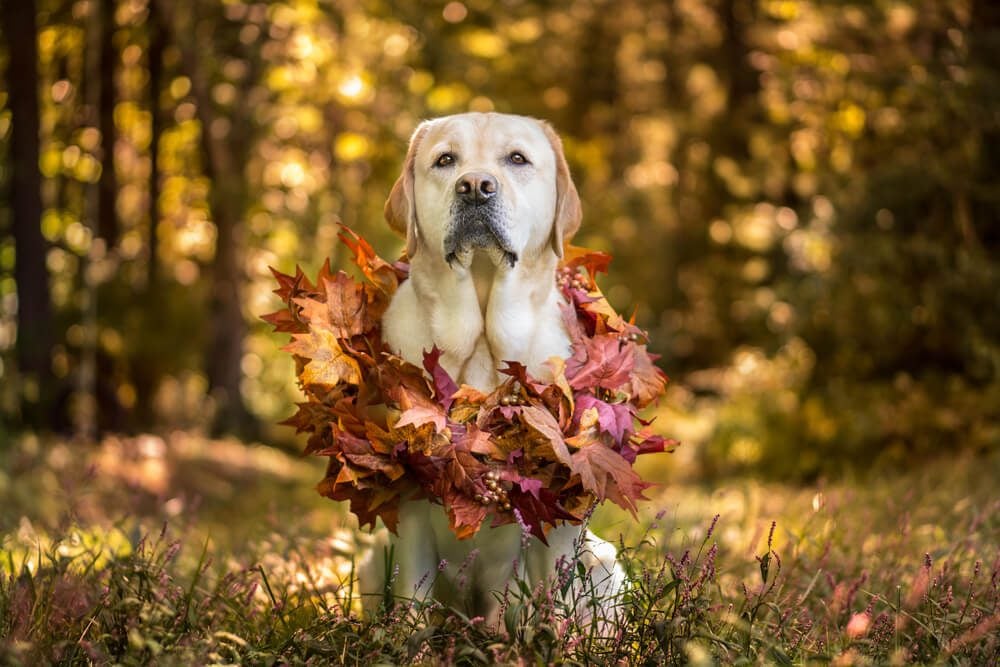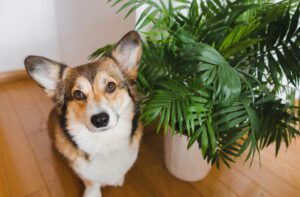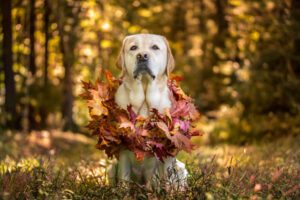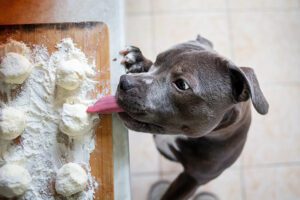Thanksgiving Pet Safety Tips: 5 Ways to Keep Your Pets Safe This Thanksgiving

Table of Contents
1. Thanksgiving Food Safety
While prepping your Thanksgiving feast, knowing which foods to keep out of your pet’s reach and jaws is important. Some people foods can be toxic to pets, while other items like turkey bones can present a choking hazard.
Discarding plate scrapings properly is vital to protect your pet from trash bin hazards.
Foods That Are Not Pet-Safe
Below are the main food items that can harm your furry friend:
- Raw Bread Dough containing yeast will continue to work in your pet’s stomach when digested. Yeast dough sugars convert into ethanol and carbon dioxide, which can be life-threatening to cats and dogs. The dough swells in the belly and can cause bowel obstruction or a bloated/distended stomach, leading to gastric dilatation and volvulus.
- Raw turkey, turkey carcasses, or turkey skin don’t belong in the dog’s bowl. Small pieces of bones can cause gastrointestinal tears or more severe injury. Turkey skin is very fatty, making it hard to digest. Fatty foods can cause pancreatitis in dogs. Your pet’s pancreas becomes swollen and inflamed.
- Allium vegetables include garlic, onions, chives, and leeks. These foods, while nonchalantly used in our cooking (especially stuffings, mashed potatoes, and green bean casserole), can cause toxicity in cats and dogs. Over time, continuous or high doses of allium vegetables can cause oxidative damage to the red blood cells, gastrointestinal distress, and even anemia.
- Xylitol and artificial sweeteners are found in many sugar-free products and baking ingredients. Watch out for candies or peanut butter desserts that contain xylitol.
- Pumpkin pie can cause gastrointestinal upset in your pet due to its high sugar content and spice mix. Nutmeg is toxic for pets. High doses can lead to hallucinations, confusion, raised heart rate, high blood pressure, dry mouth, abdominal pain, and possibly seizures. When baking, restrict access to spices and store them immediately after use.
- Nuts are not necessarily toxic for dogs but have no nutritional value to a pet’s digestive system. Many nuts can also be a choking hazard for small dogs. Avoid giving your pets nuts like almonds, hickory nuts, walnuts, pistachios, macadamia nuts, or cashews, and you’ll also avoid gastrointestinal problems, possible kidney failure, and even neurological symptoms.
- Ham and other sodium-rich meats are not the best option for your pet and can lead to increased blood pressure.
- Chocolate is always a no-go for pets, so keep any desserts or chocolates off low counters and coffee tables. Chocolate, especially dark varieties, is toxic for pets due to the theobromine and caffeine stimulants that cats and dogs cannot metabolize.
Pet-friendly Thanksgiving Foods
There are some safe foods that you can give to your pet while cooking up a storm for the Thanksgiving holiday.
- Boneless lean cuts of turkey meat, beef, or chicken (low in sodium)
- Plain, cooked vegetables like sweet potatoes, pumpkin, green beans, broccoli, carrots, celery, corn, and store-bought mushrooms.
- Peanut butter that is salt and sugar-free without artificial sweeteners.
Signs of Gastrointestinal Distress: When to Call the Poison Hotline
Below are the main indicators of a stressed digestive tract. Look out for these symptoms:
- excessive drooling
- loss of appetite / dog not eating
- bleeding or blood in dog stool
- abdominal pain
- bloating
- shock
- dehydration
If your dog or cat just ate something poisonous or displays a few of the above symptoms, call your veterinarian or Pet Poison Helpline for help immediately! A quick response time is essential when a cat or dog has consumed toxic or unsafe items. Get your pet treated as soon as possible.
How to Give a Dog CPR
If your dog stops breathing or no longer has a heartbeat, Cardiopulmonary Resuscitation (CPR) is the necessary emergency response. CPR can save your dog or cat’s life using chest compressions and artificial respirations.
Below is a quick overview of the steps to take in an emergency CPR procedure:
- Call emergency services before you begin. If help is on the way, they can take over when they arrive.
- Clear your pet’s airway. If it’s blocked, remove the item with your fingers or dislodge it by thrusting under the ribcage, much like the Heimlich Maneuver.
- Confirm whether your pet is breathing by checking chest movement or feeling for airflow by their nose. CPR is unnecessary if your pet still has a heartbeat and is breathing.
- Open the airway path by tilting the head back, ensuring the throat is open and clear.
- Cover your pet’s airway with your mouth. In smaller pets, you can cover their nose and mouth, but in larger dog breeds, cover only their nose, ensuring air does not escape through their mouth.
- Perform artificial respiration by blowing air into the airway, watching the chest rise as you do so. Allow the air to escape. Ideally, you want to give your pet 20-30 breaths in a minute.
- Begin chest compressions over your pet’s heart. Press firmly, about ten times over five seconds.
- Alternate between compressions and breathing, continuing until help arrives and assessing your pet every two minutes.
2. Social Anxiety
Remember to consider your pet if you’re hosting a Thanksgiving bash this year. Are they used to crowds of people? Will young family members attend who do not know how to treat pets?
Many pets can struggle with social anxiety in new situations. Whether it’s a crowded room or more noise than they’re accustomed to, pet owners are responsible for protecting their pets from overstimulating and intimidating scenarios.
Here are some tips to help your socially anxious pet:
Find time in your busy day to play with your pet. Taking your dog for a walk or spending quality time with them will also wear them out before your guests arrive. Hopefully, they’ll be ready for a long nap by the time the party starts.
Provide a calm and quiet space for your pet to retreat. Whether it’s a corner in your bedroom or a quiet room in the bathroom, offer your pet a calm space. Give them their favorite toy as a distraction, and remember to put their food and water nearby. If you’re closing your pet in the area, offer a litter box or pee pad to avoid any carpet stains.
Secure any exits and watch for escape routes. Distressed pets may react to overwhelming situations by running away or hiding. This is a common stress reaction, and it’s better to take the route of prevention rather than spending your Thanksgiving evening searching for a lost dog or cat.
Offer calming aids to help your pet relax. If natural calming aids are your preference, then you can opt for a dog calm vest, CBD products for animals, rescue remedy, pheromone spray or collars, or anything else your veterinarians suggest.
Ask your vet for anti-anxiety medication for dogs if your pet is regularly triggered and anxious by various situations.
Prepare your pet for social events when they’re young. You can do this with some dog ocialization training, regular social visits to parks or doggy daycares, and exposing them to people in various settings.
3. Festive Decorations
Decorations regularly used during the Thanksgiving holiday may harm your pet.
Below we’ve outlined some tips on pet-proofing your home against potential disasters.
- Place candles out of your pet’s reach. Cats can knock candles off mantels, causing fires that put yourself and guests at risk. Choosing battery-operated candles can prevent this.
- Ensure your pet eats their food instead of the pumpkins. While cooked pumpkin is safe for your pet to eat, too much or rotten pumpkin can upset their stomachs.
- Move small decorations that can be a choking hazard. Make sure your pet cannot access items with small parts if they’re teething or like to gnaw on items when stressed.
- Be alert. Since Thanksgiving marks the beginning of the festive season, be aware of tree and light decorations. Use pine needles, pinecones, lights, or glass ornaments with caution. If your pet seems curious to explore, supervise them and remove anything that seems to pique their interest.
4. Keep Pets Away from Decorative Plants
Floral arrangements may look lovely on your dinner table or mantelpiece, but it’s vital to know which plants are poisonous to cats and dogs. Opt for faux foilage or pet-safe flowers for your home decor. The ASPCA has a list of safe Fall plants that you can grow in your garden and use to adorn your table for Thanksgiving.
Here is a list of popular Fall plants that are toxic if consumed by your pet:
- Amaryllis
- Autumn crocus
- Chrysanthemum
- Acorns from oak trees
- Sweet William
- Lilies
- Poinsettias
- Schlumbergera (Christmas cactuses)
Consuming or nibbling on these plants can cause vomiting, hyper-salivation, diarrhea, incoordination, and dermatitis. Call your vet or poison hotline if you suspect your pet has eaten a toxic plant.

5. Travel Preparations
Traveling with your furry friend over the holiday season can be a grand adventure. Or perhaps you’re leaving them at home and need to prepare for a dog sitter.
To ensure that everyone enjoys their Thanksgiving holiday, consider the following tips:
Update Identification Tags and Chips
Update your pet’s microchip details, and ensure their collar has clear contact information. If your pet is not microchipped, call your vet to make an appointment before the holiday season hits. You won’t regret it!
Secure Your Pet
Make sure you have a harness or seatbelt for your dog while in transit. If your pet is in a travel carrier, make sure they’re comfortable and that the carrier is secure in case of accidents. Keep pets clear of airbags in vehicles.
Know Car Safety
Never leave pets alone in vehicles, even for short periods or with a cracked window. Rather have a friend travel with you who can take your pet for a walk or visit pet-friendly spots throughout your road trip.
Pack Wisely
Remember to pack medications, vaccine cards, microchip details, calming aids, toys, food, blankets, and anything else to make your pet’s journey comfortable and enjoyable.
Apply for Necessary Certificates
Do your homework on any requirements for traveling with your pet.
- Health certificates may be needed for visiting states or new countries.
- Emotional support animals need an ESA Travel Letter that will allow them to sit with you on various airlines. A licensed mental health professional can issue ESA letters for their patients.
- Service animals need updated licenses and clear tags or vests to signal that they’re on duty.
Hire a Pet Sitter
Never leave your pet alone at home for extended periods. Even independent cats should have someone check in and feed them. Accidents can happen, and it will be better for your peace of mind to know your animal is being taken care of by a trustworthy and professional pet sitter. They can walk your pet and provide company for animals with separation anxiety.
Buy Pet Accessories
For day trips or overnight stays, you can purchase a pet camera to monitor your pet while away. Some new toys or puzzle games will appease any boredom for your pet. Remember to supply ample water and food with a slow feeder.
Update Vaccinations
Please speak to your vet about updating your dog or cat’s vaccines before checking them into a pet-friendly hotel or traveling.



















